Sony RX100 V vs RX100 VI
The Sony Cyber-shot DSC-RX100 V and the Sony Cyber-shot DSC-RX100 VI are two digital cameras that were announced, respectively, in October 2016 and June 2018. Both the RX100 V and the RX100 VI are fixed lens compact cameras that are equipped with an one-inch sensor. Both cameras offer a resolution of 20 megapixels.
Below is an overview of the main specs of the two cameras as a starting point for the comparison.

Check RX100 V offers at
ebay.com

Check RX100 VI offers at
ebay.com
Going beyond this snapshot of core features and characteristics, what are the differences between the Sony Cyber-shot DSC-RX100 V and the Sony Cyber-shot DSC-RX100 VI? Which one should you buy? Read on to find out how these two cameras compare with respect to their body size, their imaging sensors, their shooting features, their input-output connections, and their reception by expert reviewers.
Body comparison
An illustration of the physical size and weight of the Sony RX100 V and the Sony RX100 VI is provided in the side-by-side display below. The two cameras are presented according to their relative size. Three consecutive perspectives from the front, the top, and the back are available. All size dimensions are rounded to the nearest millimeter.
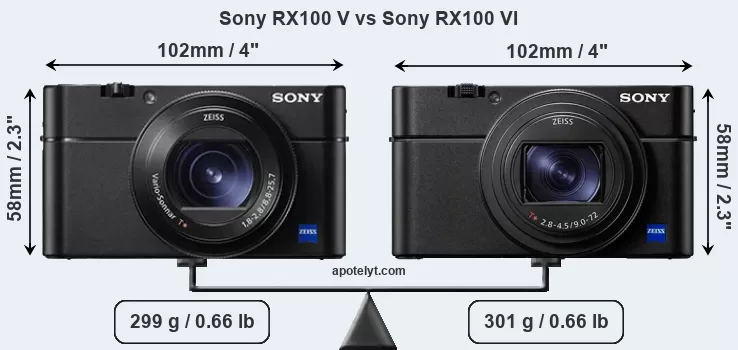
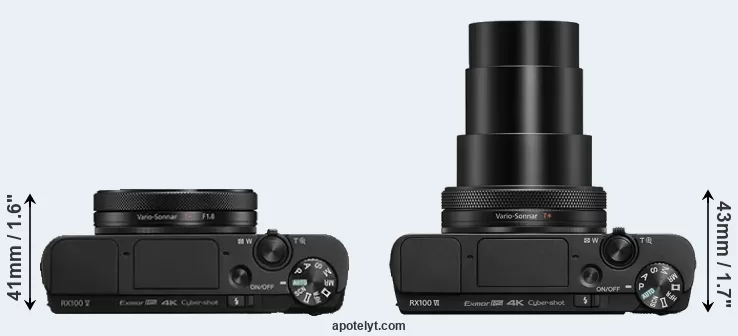
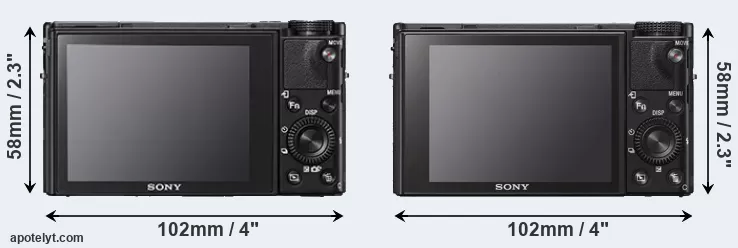
In this particular case, the Sony RX100 V and the Sony RX100 VI have exactly the same width and height, and, thus, have identically-sized bodies. However, the RX100 VI is slightly heavier (1 percent) than the RX100 V. In this context, it is worth noting that neither the RX100 V nor the RX100 VI are weather-sealed.
The battery packs of both cameras can be charged via USB, which can be very convenient when travelling.
The following table provides a synthesis of the main physical specifications of the two cameras and other similar ones. If you want to switch the focus of the display and review another camera pair, you can move across to the CAM-parator tool and choose from the broad selection of possible camera comparisons there.

| Camera Model |
Camera Width |
Camera Height |
Camera Depth |
Camera Weight |
Battery Life |
Weather Sealing |
Camera Launch |
Launch Price (USD) |
Street Price |
||
|---|---|---|---|---|---|---|---|---|---|---|---|
| 1. | Sony RX100 V | 102 mm | 58 mm | 41 mm | 299 g | 220 | n | Oct 2016 | 999 | ebay.com | |
| 2. | Sony RX100 VI | 102 mm | 58 mm | 43 mm | 301 g | 240 | n | Jun 2018 | 1,199 | ebay.com | |
| 3. | Canon G5 X | 112 mm | 76 mm | 44 mm | 353 g | 210 | n | Oct 2015 | 799 | ebay.com | |
| 4. | Fujifilm X100F | 127 mm | 75 mm | 52 mm | 469 g | 390 | n | Jan 2017 | 1,299 | ebay.com | |
| 5. | Leica C-LUX | 113 mm | 67 mm | 46 mm | 340 g | 370 | n | Jun 2018 | 1,049 | ebay.com | |
| 6. | Panasonic FZ2000 | 138 mm | 102 mm | 135 mm | 915 g | 350 | n | Sep 2016 | 1,199 | amazon.com | |
| 7. | Sony HX80 | 102 mm | 58 mm | 36 mm | 245 g | 390 | n | Mar 2016 | 349 | ebay.com | |
| 8. | Sony HX90V | 102 mm | 58 mm | 36 mm | 245 g | 360 | n | Apr 2015 | 429 | ebay.com | |
| 9. | Sony RX100 II | 102 mm | 58 mm | 38 mm | 281 g | 350 | n | Jun 2013 | 749 | ebay.com | |
| 10. | Sony RX100 III | 102 mm | 58 mm | 41 mm | 290 g | 320 | n | May 2014 | 799 | ebay.com | |
| 11. | Sony RX100 IV | 102 mm | 58 mm | 41 mm | 298 g | 280 | n | Jun 2015 | 999 | ebay.com | |
| 12. | Sony RX100 VII | 102 mm | 58 mm | 43 mm | 302 g | 260 | n | Jul 2019 | 1,199 | amazon.com | |
| 13. | Sony ZV-1 II | 106 mm | 60 mm | 47 mm | 292 g | 290 | n | May 2023 | 899 | amazon.com | |
| Note: Measurements and pricing do not include easily detachable parts, such as add-on or interchangeable lenses or optional viewfinders. | |||||||||||
Any camera decision will naturally be influenced heavily by the price. The manufacturer’s suggested retail prices give an idea on the placement of the camera in the maker’s lineup and the broader market. The RX100 V was launched at a somewhat lower price (by 17 percent) than the RX100 VI, which makes it more attractive for photographers on a tight budget. Usually, retail prices stay at first close to the launch price, but after several months, discounts become available. Later in the product cycle and, in particular, when the replacement model is about to appear, further discounting and stock clearance sales often push the camera price considerably down. Then, after the new model is out, very good deals can frequently be found on the pre-owned market.
Sensor comparison
The size of the imaging sensor is a crucial determinant of image quality. All other things equal, a large sensor will have larger individual pixel-units that offer better low-light sensitivity, wider dynamic range, and richer color-depth than smaller pixels in a sensor of the same technological generation. Moreover, a large sensor camera will give the photographer more control over depth-of-field in the image and, thus, the ability to better isolate a subject from the background. On the downside, larger sensors tend to be associated with larger, more expensive camera bodies and lenses.
Both cameras under consideration feature an one-inch sensor and have a format factor (sometimes also referred to as "crop factor") of 2.7. Within the spectrum of camera sensors, this places the review cameras among the medium-sized sensor cameras that aim to strike a balance between image quality and portability. Both cameras have a native aspect ratio (sensor width to sensor height) of 3:2.
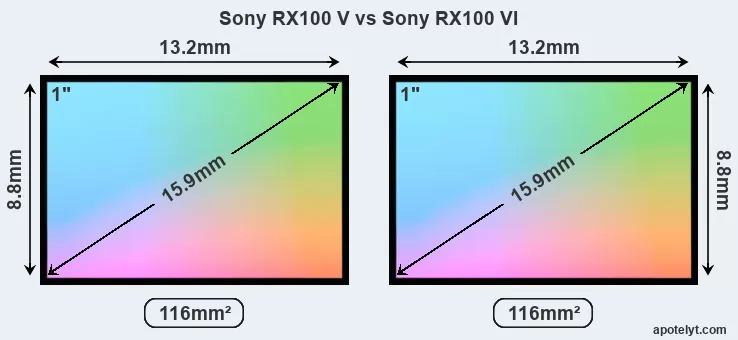
The two cameras under review do not only share the same sensor size, but also offer an identical resolution of 20 megapixels. This similarity in sensor specs implies that both the RX100 V and the RX100 VI have the same pixel density, as well as the same pixel size. It should, however, be noted that the RX100 VI is a somewhat more recent model (by 1 year and 7 months) than the RX100 V, and its sensor might have benefitted from technological advances during this time.
The RX100 VI has on-sensor phase detect pixels, which results in fast and reliable autofocus acquisition even during live view operation.
The Sony Cyber-shot DSC-RX100 V has a native sensitivity range from ISO 125 to ISO 12800, which can be extended to ISO 80-25600. The Sony Cyber-shot DSC-RX100 VI offers exactly the same ISO settings.
Technology-wise, both cameras are equipped with BSI-CMOS (Backside Illuminated Complementary Metal–Oxide–Semiconductor) sensors. Both cameras use a Bayer filter for capturing RGB colors on a square grid of photosensors. This arrangement is found in most digital cameras.
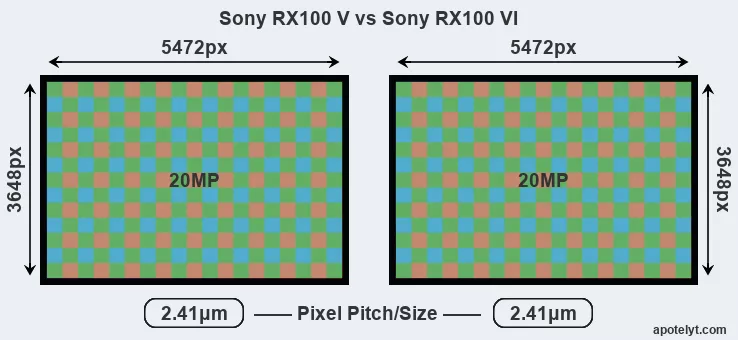
Consistent information on actual sensor performance is available from DXO Mark for many cameras. This service is based on lab testing and assigns an overall score to each camera sensor, as well as ratings for dynamic range ("DXO Landscape"), color depth ("DXO Portrait"), and low-light sensitivity ("DXO Sports"). The following table provides an overview of the physical sensor characteristics, as well as the sensor quality measurements for a selection of comparators.

| Camera Model |
Sensor Class |
Resolution (MP) |
Horiz. Pixels |
Vert. Pixels |
Video Format |
DXO Portrait |
DXO Landscape |
DXO Sports |
DXO Overall |
||
|---|---|---|---|---|---|---|---|---|---|---|---|
| 1. | Sony RX100 V | 1-inch | 20.0 | 5472 | 3648 | 4K/30p | 22.8 | 12.4 | 586 | 70 | |
| 2. | Sony RX100 VI | 1-inch | 20.0 | 5472 | 3648 | 4K/30p | 22.1 | 12.3 | 478 | 64 | |
| 3. | Canon G5 X | 1-inch | 20.0 | 5472 | 3648 | 1080/60p | 21.4 | 12.3 | 471 | 62 | |
| 4. | Fujifilm X100F | APS-C | 24.0 | 6000 | 4000 | 1080/60p | 23.9 | 13.2 | 1704 | 81 | |
| 5. | Leica C-LUX | 1-inch | 20.0 | 5472 | 3648 | 4K/30p | 22.1 | 12.3 | 481 | 64 | |
| 6. | Panasonic FZ2000 | 1-inch | 20.0 | 5472 | 3648 | 4K/30p | 23.0 | 12.6 | 538 | 70 | |
| 7. | Sony HX80 | 1/2.3 | 18.0 | 4896 | 3672 | 1080/60p | 20.4 | 11.8 | 822 | 48 | |
| 8. | Sony HX90V | 1/2.3 | 18.0 | 4896 | 3672 | 1080/60p | 20.2 | 11.6 | 738 | 47 | |
| 9. | Sony RX100 II | 1-inch | 20.0 | 5472 | 3648 | 1080/60p | 22.5 | 12.4 | 483 | 67 | |
| 10. | Sony RX100 III | 1-inch | 20.0 | 5472 | 3648 | 1080/60p | 22.4 | 12.3 | 495 | 67 | |
| 11. | Sony RX100 IV | 1-inch | 20.0 | 5472 | 3648 | 4K/30p | 22.8 | 12.6 | 591 | 70 | |
| 12. | Sony RX100 VII | 1-inch | 20.0 | 5472 | 3648 | 4K/30p | 21.8 | 12.4 | 418 | 63 | |
| 13. | Sony ZV-1 II | 1-inch | 20.0 | 5472 | 3648 | 4K/30p | 22.3 | 12.9 | 965 | 67 | |
| Note: DXO values in italics represent estimates based on sensor size and age. | |||||||||||
Many modern cameras are not only capable of taking still images, but also of capturing video footage. The two cameras under consideration both have sensors whose read-out speed is fast enough to capture moving pictures, and both provide the same movie specifications (4K/30p).
Feature comparison
Beyond body and sensor, cameras can and do differ across a range of features. The RX100 V and the RX100 VI are similar in the sense that both feature an electronic viewfinder, which is helpful when framing images in bright sunlight. Moreover, their viewfinders offer an identical resolution of 2359k dots. The table below summarizes some of the other core capabilities of the Sony RX100 V and Sony RX100 VI in connection with corresponding information for a sample of similar cameras.

| Camera Model |
Viewfinder (Type or 000 dots) |
Control Panel (yes/no) |
LCD Specifications (inch/000 dots) |
LCD Attach- ment |
Touch Screen (yes/no) |
Max Shutter Speed * |
Max Shutter Flaps * |
Built-in Flash (yes/no) |
Built-in Image Stab |
||
|---|---|---|---|---|---|---|---|---|---|---|---|
| 1. | Sony RX100 V | 2359 | n | 3.0 / 1229 | tilting | n | 1/2000s | 24.0/s | Y | Y | |
| 2. | Sony RX100 VI | 2359 | n | 3.0 / 1229 | tilting | Y | 1/2000s | 24.0/s | Y | Y | |
| 3. | Canon G5 X | 2360 | n | 3.0 / 1040 | swivel | Y | 1/2000s | 5.9/s | Y | Y | |
| 4. | Fujifilm X100F | 2360 | n | 3.0 / 1040 | fixed | n | 1/4000s | 8.0/s | Y | n | |
| 5. | Leica C-LUX | 2330 | n | 3.0 / 1240 | fixed | Y | 1/2000s | 10.0/s | Y | Y | |
| 6. | Panasonic FZ2000 | 2360 | n | 3.0 / 1040 | swivel | Y | 1/4000s | 12.0/s | Y | Y | |
| 7. | Sony HX80 | 638 | n | 3.0 / 922 | tilting | n | 1/2000s | 10.0/s | Y | Y | |
| 8. | Sony HX90V | 638 | n | 3.0 / 921 | tilting | n | 1/2000s | 10.0/s | Y | Y | |
| 9. | Sony RX100 II | optional | n | 3.0 / 1229 | tilting | n | 1/2000s | 10.0/s | Y | Y | |
| 10. | Sony RX100 III | 1440 | n | 3.0 / 1229 | tilting | n | 1/2000s | 10.0/s | Y | Y | |
| 11. | Sony RX100 IV | 2359 | n | 3.0 / 1228 | tilting | n | 1/2000s | 16.0/s | Y | Y | |
| 12. | Sony RX100 VII | 2359 | n | 3.0 / 921 | tilting | Y | 1/2000s | 90.0/s | Y | Y | |
| 13. | Sony ZV-1 II | none | n | 3.0 / 922 | swivel | Y | 1/2000s | 24.0/s | n | n | |
| Note: *) Information refers to the mechanical shutter, unless the camera only has an electronic one. | |||||||||||
One differentiating feature between the two cameras concerns the touch sensitivity of the rear screen. The RX100 VI has a touchscreen, while the RX100 V has a conventional panel. Touch control can be particularly helpful, for example, for setting the focus point.
Both cameras have an articulated rear screen that can be turned to be front-facing. This feature will be particularly appreciated by vloggers and photographers who are interested in taking selfies.The reported shutter speed information refers to the use of the mechanical shutter. Yet, some cameras only have an electronic shutter, while others have an electronic shutter in addition to a mechanical one. In fact, both cameras under consideration feature an electronic shutter, which makes completely silent shooting possible. However, this mode is less suitable for photographing moving objects (risk of rolling shutter) or shooting under artificial light sources (risk of flickering).
Both the RX100 V and the RX100 VI have zoom lenses built in. The RX100 V has a 24-70mm f/1.8-2.8 optic and the RX100 VI offers a 24-200mm f/2.8-4.5 (focal lengths in full frame equivalent terms). Hence, the RX100 V and RX100 VI provide the same view at the wide-angle end, but the RX100 VI has more tele-photo reach at the long end. The RX100 V offers the faster maximum aperture.
Concerning the storage of imaging data, both the RX100 V and the RX100 VI write their files to SDXC or Memory Stick PRO Duo cards. Both cameras can use UHS-I cards, which provide for Ultra High Speed data transfer of up to 104 MB/s.
Connectivity comparison
For some imaging applications, the extent to which a camera can communicate with its environment can be an important aspect in the camera decision process. The table below provides an overview of the connectivity of the Sony Cyber-shot DSC-RX100 V and Sony Cyber-shot DSC-RX100 VI and, in particular, the interfaces the cameras (and selected comparators) provide for accessory control and data transfer.

| Camera Model |
Hotshoe Port |
Internal Mic / Speaker |
Microphone Port |
Headphone Port |
HDMI Port |
USB Port |
WiFi Support |
NFC Support |
Bluetooth Support |
||
|---|---|---|---|---|---|---|---|---|---|---|---|
| 1. | Sony RX100 V | - | stereo / mono | - | - | micro | 2.0 | Y | Y | - | |
| 2. | Sony RX100 VI | - | stereo / mono | - | - | micro | 2.0 | Y | Y | Y | |
| 3. | Canon G5 X | Y | stereo / mono | - | - | mini | 2.0 | Y | Y | - | |
| 4. | Fujifilm X100F | Y | stereo / mono | Y | - | micro | 2.0 | Y | - | - | |
| 5. | Leica C-LUX | - | stereo / mono | - | - | micro | 2.0 | Y | - | - | |
| 6. | Panasonic FZ2000 | Y | stereo / mono | Y | Y | micro | 2.0 | Y | - | - | |
| 7. | Sony HX80 | - | stereo / mono | - | - | micro | 2.0 | Y | Y | - | |
| 8. | Sony HX90V | - | stereo / mono | - | - | micro | 2.0 | Y | Y | - | |
| 9. | Sony RX100 II | Y | stereo / mono | - | - | micro | 2.0 | Y | Y | - | |
| 10. | Sony RX100 III | - | stereo / mono | - | - | micro | 2.0 | Y | Y | - | |
| 11. | Sony RX100 IV | - | stereo / mono | - | - | micro | 2.0 | Y | Y | - | |
| 12. | Sony RX100 VII | - | stereo / mono | Y | - | micro | 2.0 | Y | Y | Y | |
| 13. | Sony ZV-1 II | Y | stereo / mono | Y | - | micro | 2.0 | Y | - | Y |
Both the RX100 V and the RX100 VI have been discontinued, but can regularly be found used on ebay. The RX100 V was replaced by the Sony RX100 VI, while the RX100 VI was followed by the Sony RX100 VII. Further information on the features and operation of the RX100 V and RX100 VI can be found, respectively, in the Sony RX100 V Manual (free pdf) or the online Sony RX100 VI Manual.
Review summary
So what conclusions can be drawn? Which of the two cameras – the Sony RX100 V or the Sony RX100 VI – has the upper hand? Is one clearly better than the other? The listing below highlights the relative strengths of the two models.
Reasons to prefer the Sony Cyber-shot DSC-RX100 V:
- Better light gathering: Has a lens with a wider maximum aperture (f/1.8 vs f/2.8).
- More affordable: Was introduced into a lower priced segment (17 percent cheaper at launch).
- More heavily discounted: Has been on the market for longer (launched in October 2016).
Advantages of the Sony Cyber-shot DSC-RX100 VI:
- Better live-view autofocus: Features on-sensor phase-detection for more confident autofocus.
- Fewer buttons to press: Has a touchscreen to facilitate handling and shooting adjustments.
- More tele-reach: Has a longer tele-lens for perspective compression and subject magnification.
- Easier wireless transfer: Supports Bluetooth for image sharing without cables.
- More modern: Was introduced somewhat (1 year and 7 months) more recently.
If the count of individual advantages (bullet points above) is taken as a guide, the RX100 VI emerges as the winner of the match-up (5 : 3 points). However, the relative importance of the various individual camera aspects will vary according to personal preferences and needs, so that you might like to apply corresponding weights to the particular features before making a decision on a new camera. A professional wildlife photographer will view the differences between cameras in a way that diverges from the perspective of a family photog, and a person interested in architecture has distinct needs from a sports shooter. Hence, the decision which camera is best and worth buying is often a very personal one.
How about other alternatives? Do the specifications of the Sony RX100 V and the Sony RX100 VI place the cameras among the top in their class? Find out in the latest Best Travel-Zoom Camera listing whether the two cameras rank among the cream of the crop.
In any case, while the comparison of the spec-sheets of cameras can offer a general idea of their imaging potential, it says little about, for example, the shooting experience and imaging performance of the RX100 V and the RX100 VI in practical situations. User reviews that are available, for instance, at amazon can sometimes shed light on these issues, but such feedback is all too often partial, inconsistent, and inaccurate.
Expert reviews
This is where reviews by experts come in. The following table reports the overall ratings of the cameras as published by some of the major camera review sites (amateurphotographer [AP], cameralabs [CL], digitalcameraworld [DCW], dpreview [DPR], ephotozine [EPZ], photographyblog [PB]). As can be seen, the professional reviewers agree in many cases on the quality of different cameras, but sometimes their assessments diverge, reinforcing the earlier point that a camera decision is often a very personal choice.

| Camera Model |
AP score |
CL score |
DCW score |
DPR score |
EPZ score |
PB score |
Camera Launch |
Launch Price (USD) |
Street Price |
||
|---|---|---|---|---|---|---|---|---|---|---|---|
| 1. | Sony RX100 V | 4.5/5 | + + | .. | 83/100 | 4/5 | 4.5/5 | Oct 2016 | 999 | ebay.com | |
| 2. | Sony RX100 VI | 4.5/5 | + + | .. | 83/100 | 4/5 | 4.5/5 | Jun 2018 | 1,199 | ebay.com | |
| 3. | Canon G5 X | 5/5 | + + | .. | 78/100 | 4.5/5 | 4.5/5 | Oct 2015 | 799 | ebay.com | |
| 4. | Fujifilm X100F | 5/5 | + | 3.9/5 | 83/100 | 4.5/5 | 4.5/5 | Jan 2017 | 1,299 | ebay.com | |
| 5. | Leica C-LUX | .. | .. | 3.5/5 | .. | 4.5/5 | 4/5 | Jun 2018 | 1,049 | ebay.com | |
| 6. | Panasonic FZ2000 | .. | + | .. | 82/100 | 4.5/5 | 5/5 | Sep 2016 | 1,199 | amazon.com | |
| 7. | Sony HX80 | .. | .. | .. | .. | .. | .. | Mar 2016 | 349 | ebay.com | |
| 8. | Sony HX90V | 4/5 | + + | .. | .. | 4/5 | 4.5/5 | Apr 2015 | 429 | ebay.com | |
| 9. | Sony RX100 II | 5/5 | + + | .. | 79/100 | 4.5/5 | 4.5/5 | Jun 2013 | 749 | ebay.com | |
| 10. | Sony RX100 III | 5/5 | + + | .. | 82/100 | 4.5/5 | 5/5 | May 2014 | 799 | ebay.com | |
| 11. | Sony RX100 IV | 4.5/5 | + + | .. | 85/100 | 4/5 | 4.5/5 | Jun 2015 | 999 | ebay.com | |
| 12. | Sony RX100 VII | 4.5/5 | .. | 4/5 | .. | 4/5 | 5/5 | Jul 2019 | 1,199 | amazon.com | |
| 13. | Sony ZV-1 II | 4.5/5 | .. | 3.5/5 | 83/100 | 3.5/5 | 4.5/5 | May 2023 | 899 | amazon.com | |
| Note: (+ +) highly recommended; (+) recommended; (o) reviewed; (..) not available. | |||||||||||
Care should be taken when interpreting the review scores above, though. The ratings are only valid when referring to cameras in the same category and of the same age. A score, therefore, has to be seen in close connection to the price and market introduction time of the camera, and comparing ratings of very distinct cameras or ones that are far apart in terms of their release date have little meaning. Also, please note that some of the review sites have changed their methodology and reporting over time.

Check RX100 V offers at
ebay.com

Check RX100 VI offers at
ebay.com
Other camera comparisons
Did this review help to inform your camera decision process? If you would like to see a different side-by-side camera review, just make a corresponding selection in the search boxes below. As an alternative, you can also directly jump to any one of the listed comparisons that were previously generated by the CAM-parator tool.
- Canon 750D vs Sony RX100 VI
- Canon SX530 vs Sony RX100 VI
- Canon SX730 vs Sony RX100 V
- Canon T3 vs Sony RX100 VI
- Fujifilm X-E2S vs Sony RX100 V
- Leica M Typ 262 vs Sony RX100 V
- Nikon D100 vs Sony RX100 VI
- Olympus E-M1 vs Sony RX100 V
- Panasonic G100 vs Sony RX100 V
- Panasonic GF6 vs Sony RX100 V
- Panasonic ZS100 vs Sony RX100 VI
- Sony A7R vs Sony RX100 VI
Specifications: Sony RX100 V vs Sony RX100 VI
Below is a side-by-side comparison of the specs of the two cameras to facilitate a quick review of their differences and common features.
| Camera Model | Sony RX100 V | Sony RX100 VI |
|---|---|---|
| Camera Type | Fixed lens compact camera | Fixed lens compact camera |
| Camera Lens | 24-70mm f/1.8-2.8 | 24-200mm f/2.8-4.5 |
| Launch Date | October 2016 | June 2018 |
| Launch Price | USD 999 | USD 1,199 |
| Sensor Specs | Sony RX100 V | Sony RX100 VI |
| Sensor Technology | BSI-CMOS | BSI-CMOS |
| Sensor Format | 1" Sensor | 1" Sensor |
| Sensor Size | 13.2 x 8.8 mm | 13.2 x 8.8 mm |
| Sensor Area | 116.16 mm2 | 116.16 mm2 |
| Sensor Diagonal | 15.9 mm | 15.9 mm |
| Crop Factor | 2.7x | 2.7x |
| Sensor Resolution | 20 Megapixels | 20 Megapixels |
| Image Resolution | 5472 x 3648 pixels | 5472 x 3648 pixels |
| Pixel Pitch | 2.41 μm | 2.41 μm |
| Pixel Density | 17.18 MP/cm2 | 17.18 MP/cm2 |
| Moiré control | Anti-Alias filter | Anti-Alias filter |
| Movie Capability | 4K/30p Video | 4K/30p Video |
| ISO Setting | 125 - 12,800 ISO | 125 - 12,800 ISO |
| ISO Boost | 80 - 25,600 ISO | 80 - 25,600 ISO |
| Image Processor | BIONZ X | BIONZ X |
| DXO Sensor Quality (score) | 70 | .. |
| DXO Color Depth (bits) | 22.8 | .. |
| DXO Dynamic Range (EV) | 12.4 | .. |
| DXO Low Light (ISO) | 586 | .. |
| Screen Specs | Sony RX100 V | Sony RX100 VI |
| Viewfinder Type | Electronic viewfinder | Electronic viewfinder |
| Viewfinder Field of View | 100% | 100% |
| Viewfinder Magnification | 0.59x | 0.59x |
| Viewfinder Resolution | 2359k dots | 2359k dots |
| LCD Framing | Live View | Live View |
| Rear LCD Size | 3.0inch | 3.0inch |
| LCD Resolution | 1229k dots | 1229k dots |
| LCD Attachment | Tilting screen | Tilting screen |
| Touch Input | no Touchscreen | Touchscreen |
| Shooting Specs | Sony RX100 V | Sony RX100 VI |
| Focus System | Contrast-detect AF | On-Sensor Phase-detect |
| Manual Focusing Aid | Focus Peaking | Focus Peaking |
| Max Shutter Speed (mechanical) | 1/2000s | 1/2000s |
| Continuous Shooting | 24 shutter flaps/s | 24 shutter flaps/s |
| Electronic Shutter | up to 1/32000s | up to 1/32000s |
| Fill Flash | Built-in Flash | Built-in Flash |
| Storage Medium | MS or SDXC cards | MS or SDXC cards |
| Single or Dual Card Slots | Single card slot | Single card slot |
| UHS card support | UHS-I | UHS-I |
| Connectivity Specs | Sony RX100 V | Sony RX100 VI |
| External Flash | no Hotshoe | no Hotshoe |
| USB Connector | USB 2.0 | USB 2.0 |
| HDMI Port | micro HDMI | micro HDMI |
| Wifi Support | Wifi built-in | Wifi built-in |
| Near-Field Communication | NFC built-in | NFC built-in |
| Bluetooth Support | no Bluetooth | Bluetooth built-in |
| Body Specs | Sony RX100 V | Sony RX100 VI |
| Battery Type | Sony NP-BX1 | Sony NP-BX1 |
| Battery Life (CIPA) | 220 shots per charge | 240 shots per charge |
| In-Camera Charging | USB charging | USB charging |
| Body Dimensions |
102 x 58 x 41 mm (4.0 x 2.3 x 1.6 in) |
102 x 58 x 43 mm (4.0 x 2.3 x 1.7 in) |
| Camera Weight | 299 g (10.5 oz) | 301 g (10.6 oz) |

Check RX100 V offers at
ebay.com

Check RX100 VI offers at
ebay.com
Did you notice an error on this page? If so, please get in touch, so that we can correct the information.

